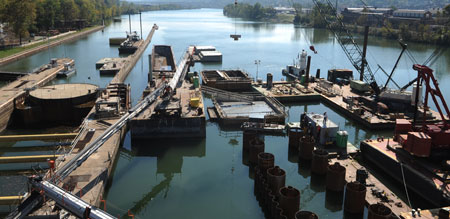
Pittsburgh Tribune-Review
26 October 2008:
By Mike Cronin
An Army Corps of Engineers project to rebuild locks and dams on the lower Monongahela River might cost twice as much and take three times longer to complete than initially estimated, officials concede.
The $750 million project that began in 1995 and was to be finished in 2004 has morphed into a delayed effort that will not be finished until at least 2022 at a cost of $1.5 billion, said Stephen R. Fritz of the Corps of Engineers and the project's manager. And, the work could be prolonged even further and cost even more, Fritz said.
"I've been frustrated with the lack of progress," said Stephen Little, president and CEO of Kentucky-based Crounse Corp., which every year hauls 35 million tons of cargo -- mostly coal -- on Pittsburgh-area rivers. "My concern is that the federal government has not fully and efficiently spent money on the projects."
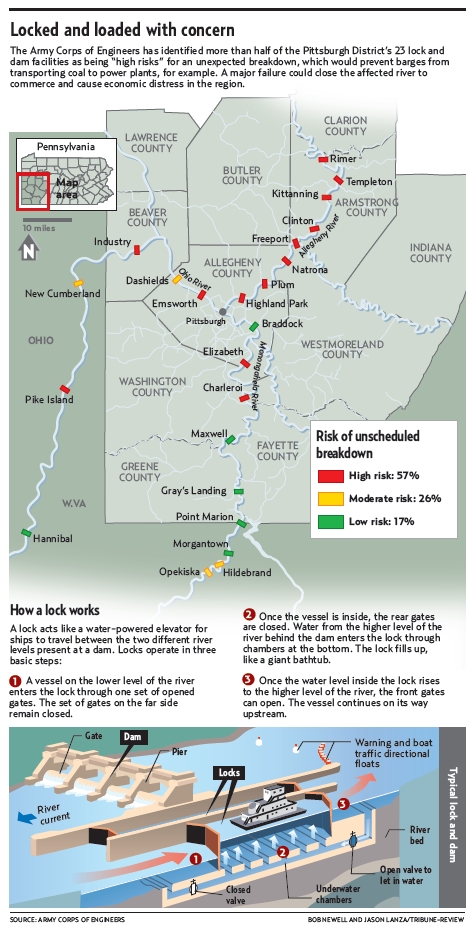
Locked and loaded - Region's locks and dams - View/Print above image as a high resolution.PDF file
A major portion of Western Pennsylvania's economy depends on its rivers. But the Corps identifies many of the aging locks and dams as "critically near failure" or "highly unreliable."

Construction - Keith Hodan/Tribune-Review
A July report by the Corps acknowledged inefficient management of the lower Mon projects that pushed up costs.
"We have taken too long and spent too much money on a couple of projects," said Gary Loew, the Corps of Engineers' chief of programs in Washington, D.C.
Repairs to the dams and locks are paid from the federal Inland Waterways Trust Fund and congressional appropriations to the Army Corps of Engineers. The money in the fund comes from a 20-cent-per-gallon tax on diesel paid by the commercial towing industry, including barge operators.
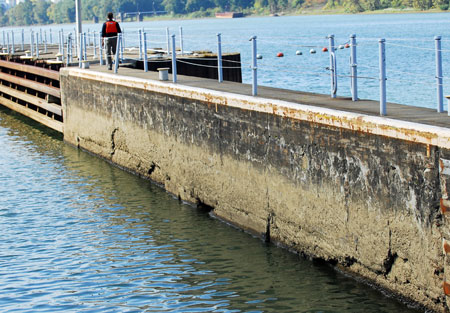
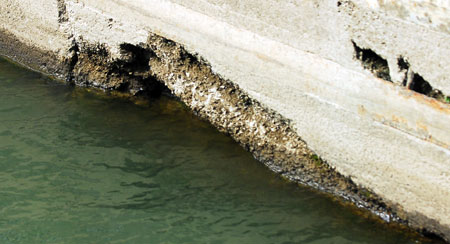
Concrete Erosion - Keith Hodan/Tribune-Review
As of last week, the fund contained about $28 million for all projects nationwide, said Mark Mugler, who manages the funding of Corps projects.
The Corps cannot access trust-fund money unless enough exists to match congressional appropriations for lock-and-dam repairs, said Col. Mike Crall, the agency's Pittsburgh District commander and head engineer.
To keep the district's locks and dams operating, workers have had to perform maintenance "Band-Aids" on an as-needed basis for decades, said Corps spokesman Jeff Hawk.
For example, the 101-year-old Elizabeth dam is "unsafe and critically near failure" and its locks are "highly unreliable," while the 76-year-old operating lock at Charleroi is also "highly unreliable," Hawk said.
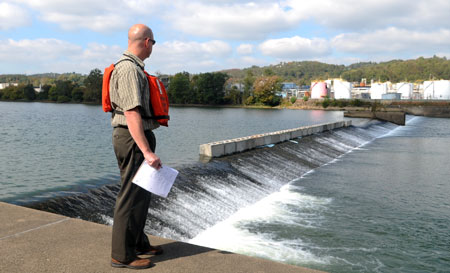
Steve Fritz- Keith Hodan/Tribune-Review
The Corps completed one-third of the lower Mon project when it replaced the Braddock dam in 2004. It still needs to replace the locks at Charleroi and remove the entire Elizabeth navigation facility, Fritz said.
Part of the blame for the delays and ballooning costs goes to Congress, Little and other waterways business executives believe.
"(Congress) allocate(s) funds on a year-to-year basis," Little said. "No one knows how much money is going to be appropriated. That's like building a house and not knowing how much money is going to be there the following year."
After receiving an average of $61 million each year during the past three years, the Pittsburgh District will receive between $19.1 million and $40.8 million for fiscal year 2009, depending on what Congress ultimately appropriates.
Talks between the Washington-based Waterways Council Inc., a nonprofit inland waterways trade group, and the Corps to improve efficiency have continued for months, Loew said.
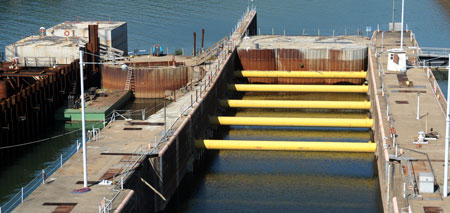
Temporary Supports - Keith Hodan/Tribune-Review
"We're currently having discussions with the waterways industry to work on changing business practices," he said.
One idea is to increase the diesel tax to replenish the trust fund, said Rep. Mike Doyle, D-Forest Hills.
"But there is a concern that could hurt in this economy," Doyle said. "Another proposal is to waive the federal matching requirement and directly fund projects. But in this (economic) climate, I'm not optimistic we could do that in the short term."
Waterways business executives oppose any tax increase.
"Why would people continue to pay taxes on diesel fuel with this much waste and inefficiency?" asked Barry Palmer, president and CEO of the Waterways Council.
Doyle points out the diesel tax is no different than what drivers contribute to the Highway Trust Fund when they pay a 19-cent federal fuel tax.
"Waterways users have to remember that they're not the only ones paying," Doyle said. "They're getting a 50-percent subsidy that every taxpayer is paying for (through annual appropriations)."
Still, the Charleroi and Elizabeth stations must be fixed.
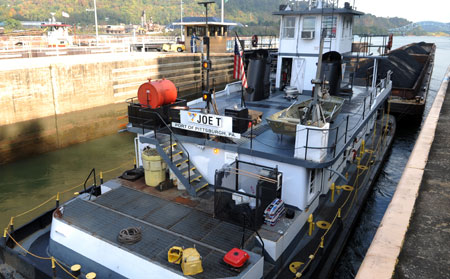
Traffic still keeps moving - Keith Hodan/Tribune-Review
The locks and dams in the Pittsburgh area provide $10 billion in wages and jobs for about 200,000 people and more than $3 billion in local, state and federal tax money, according to Port of Pittsburgh Commission data. A major failure could create gridlock that slows delivery of roughly $9.1 billion in goods that travel along Pittsburgh's rivers each year.
A lock wall or dam collapse at one of the 23 locks and dams in the district, which stretches from western New York into West Virginia, becomes more likely every year and is "potentially catastrophic," said James McCarville, executive director of the Port of Pittsburgh Commission.
Officials from publicly traded companies with operations along the river would not say how much money they could lose if a navigational structure failed.
But Doug Colafella, a spokesman for Allegheny Energy -- which has three coal-fired power plants along the lower Mon -- said the company would have to pay truckers to transport the coal it needs to generate electricity.
With a delay in coal delivery "you could have a price increase in electricity," said Ray Dotter, spokesman for PJM Interconnection in Valley Forge, which manages the power supply system in the region.
Allegheny Energy has a contingency plan for coal delivery-by-road if a lock-and-dam failure prevented barge transport, Colafella said. It would take 40 truckloads of coal to equal the 1,000 tons one barge can carry, Colafella said.
"But we'd have to do it," he said. "We'd be running 640 trucks a day -- a virtual caravan of trucks every day for those three power stations."
Mike Cronin can be reached at "mailto:mcronin@tribweb.com" or 412-320-7884.